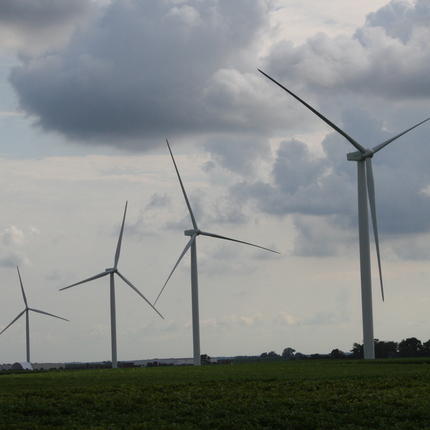By Katie Rock, former staff member
While Iowa leads the Midwest in wind energy production, limiting the environmental impacts of wind farms is important to the long-term health of our landscape. MidAmerican Energy is in the process of applying for a 30-year incidental take permit to cover endangered and threatened species in Iowa. These species include three species of bats: the Indiana bat, Northern long-eared bat, and little brown bat; and the bald eagle.
MidAmerican goes to great lengths to minimize the impact of wind energy to these species including investing in habitat restoration and siting farms outside nesting habitats. But, some amount of damage and death is unavoidable. This permit sets an agreement among MidAmerican, the U.S. Fish and Wildlife Service, and the federal government on what is an unacceptable amount of damage.
You can read their plans and permit application here, and submit comments yourself: https://www.fws.gov/midwest/rockisland/te/MidAmericanHCP.html
Below are comments submitted by the Center for Rural Affairs in regards to this permit application.
The Center for Rural Affairs is a nonprofit established in 1973 and based in Lyons, Nebraska and an office in Nevada, Iowa. The Center works to promote social and economic justice, environmental stewardship, and strengthen rural communities. Essential to these goals is bringing new opportunities to rural communities and assisting them identifying ways to improve their lives. Renewable energy development, especially wind energy, has proven to be such an opportunity for rural Iowa.
General Comments
Iowa has claimed a position as a leader in wind energy with the potential to produce 772,722 megawatts from wind according to the National Renewable Energy Laboratory (NREL). Currently, Iowa generates about 37 percent of its electricity from wind energy, ranking it third in the nation for wind energy production. While wind energy has proven to be an effective economic development tool that has been embraced by the state, it is also essential that project developers and operators take steps to avoid impacts on vulnerable animal species in the region that could be affected by wind energy systems.
The draft habitat conservation plan is a useful blueprint and stands as a good example for other generation owners and operators. Avoidance, mitigation, and conservation are important components of wind energy development and operation. It is clear from this plan that MidAmerican intends to make the efforts necessary to avoid harm when possible, mitigate impacts where present, and identify opportunities for conservation of impacted species.
Technology Integration
MidAmerican has made large investments in research to understand the demographics and habits of protected species in Iowa and nationally. This effort has a track record of success in helping to avoid and minimize potential impacts. While this plan includes mitigation measures and outlines procedures for adaptation, there should be a clearer focus on integrating new technology. Over the lifespan of the permit, there will likely be new technologies that could reduce the impact of generation systems on wildlife. Many technological developments on the horizon could significantly improve attempts at habitat conservation and avoiding collisions with several species included in this plan. It would be good practice to include a process for assessing new technologies, the benefits and drawbacks to avoidance and conservation they present, and the potential for integrating these technologies into existing systems to meet the goals of this plan.
Acquisition Process
Avoidance and mitigation is only half of the focus of MidAmerican’s conservation plan. MidAmerican’s first goal focuses on contributing to the long-term persistence of covered species with projects that support the survival and recovery in Iowa. This objective is achieved through funding to acquire, protect, and restore habitat in large blocks for the covered species.
The acquisition of acres for habitat conservation and restoration is a positive inclusion, but there is a missed opportunity to include more potential partners and other stakeholders to support this effort. Identifying partners may be particularly important if MidAmerican does in fact intend to protect or build up artificial structures such as barns to provide habitat for bat species. While it isn’t necessary to offer an exhaustive list, including a process that allows MidAmerican to identify potential partners and incorporate their insight or expertise into the efforts outlined in this plan would demonstrate commitment to including a broad group of stakeholders on conservation and improvement measures.
Iowa has numerous groups and organizations that work to preserve habitat or the structures that can act as habitat, and they can also assist in publicizing the conservation efforts and further building support for preserving habitat. By broadening the involvement of organizations and stakeholders, MidAmerican could potentially lower the long-term costs of habitat conservation and increase awareness of pressures like white nose syndrome and overuse of pesticides. It would be helpful as part of this plan if MidAmerican could outline a proposal for identifying potential partners and gathering stakeholder feedback for ongoing conservation measures related to projects.
Conclusion
As wind energy continues to expand in Iowa, it would reassure the public if utilities and transmission provides presented a unified effort on implementing their habitat conservation plans. The committed efforts described in this plan should be demonstrated for all parties looking to invest in Iowa. As rural communities are asked to carry the growing renewable energy infrastructure it should not come at the expense of our natural world.





